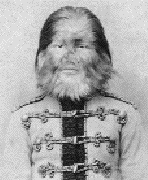 |
| A Face Only a Mom Could Love: Jo Jo the Dog-Faced Boy was a popular sideshow attraction in a traveling circus in the early 1900s. Photograph courtesy of Deborah Taylor Hollis |
Dog-faced boy leads to lifetime of curiosity
By Deborah Taylor Hollis
I was probably 4 or 5 years old the first time I saw Jo Jo the Dog-Faced Boy. I'll never forget that moment, sorting through the pile of black-and-white photographs my grandmother kept loose in the bottom drawer of the sideboard.
From the hundreds of pictures in that enormous pile (she never did make a scrapbook) floated up this image--long, fine hair covered his entire face, ears and pugish nose. Since I was looking at family pictures, my first thought was that he was some kind of relative. I took that photo and ran to my mom, asking her eagerly, "Mommy, who? Who?" In that one enthralling moment, as Mom explained what I had found, I was forever hooked on the people that made up the circus. I was a sideshow addict.
The sideshow evolved as a result of man's curiosity about the world around him, his fascination with things strange and wondrous. People, animals, even garden vegetables that are out of the norm will draw a crowd whenever they appear. Entrepreneurs like P.T. Barnum found not only that they could make money on people with curious qualities, but that circus life could also help these outcasts. Without the circus, they would be unable to work or make a living. In the sideshow, they had a job and a family and found acceptance in a social structure. If you're on an isolated farm, it may have been easy to live with four legs, but in the industrialized world, those same four legs are not going to make you an ideal candidate for secretarial school.
I've always wondered why I'm so drawn to the sideshow performers of old, the outcasts with physical oddities that not only survived childhood but had long and happy lives. Maybe the curiosity is built into our culture. As children, we all grew up watching with fascination the munchkins in The Wizard of Oz. Many of those performers were traveling in circus acts as "little people" (proportionately correct smaller versions of us all) "dwarves" (short-limbed people with large heads and almost average size torsos) or "midgets" (a term that often included both of these groups).
Or maybe some of us have always felt "a little bit outcast," and so we gravitate to others that are like us--only more prominently so. Maybe it's just the mystique of the bizarre.
I have visited every sideshow I could find since childhood, checking out the two-headed calves and the fetuses in jars. I saw the last of the performing "freaks." Most of the great acts have been dead for years, and their memories survive only in the photographs that were professionally taken to sell during their heyday. I love to wander through stacks of pictures and wonder how life was lived by the Siamese twins, the three-armed man or the true hermaphrodites.
Sometime during the '60s, we got politically correct and quit staring at physically different people, and in some misguided effort to "save them" from "degrading themselves by public display," we destroyed their livelihood and banned side-shows, closing the last one in 1994.
Even in the politically correct '90s, very few employers will give receptionist jobs to "monkey girls" or let an engineer with a partial twin sticking out of his chest come to the IBM summer picnic. But, continuing the tradition, our "freaks" still perform--on television.
Between Sally, Phil, Jerry and Oprah, we can see them every afternoon. With modern artistic shows, the Chinese contortionists now command $25 per ticket, and televised series and movies like The Elephant Man give us all the voyeurism we can handle. Well, most of us, anyway.
I search out the rare and unusual with a passion. I can't take a vacation without stopping at every tourist trap on the way, looking at the pickled snakes with double heads, the grotesque trees, the "Mystery Spot" (right up the road in Santa Cruz), and talking with anyone who knew the performers of old. I guess I'm still trying to capture that magic of childhood, that wondrous moment when I found out about the circus. I'm guess I'm searching for Jo Jo, that soft-eyed, dog-faced boy.
Deborah Taylor Hollis is a frequent contributor to the Resident.
This article appeared in the Willow Glen Resident, April 2, 1997.
©1997 Metro Publishing, Inc. All rights reserved.
|

